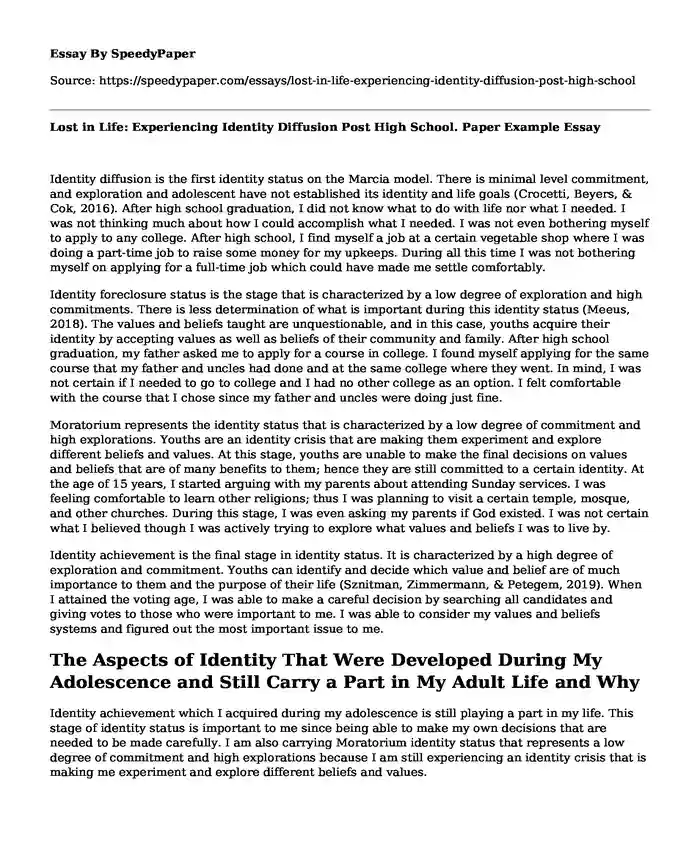
| Type of paper: | Course work |
| Categories: | Education Personal experience Personal development Developmental psychology |
| Pages: | 3 |
| Wordcount: | 792 words |
Identity diffusion is the first identity status on the Marcia model. There is minimal level commitment, and exploration and adolescent have not established its identity and life goals (Crocetti, Beyers, & Cok, 2016). After high school graduation, I did not know what to do with life nor what I needed. I was not thinking much about how I could accomplish what I needed. I was not even bothering myself to apply to any college. After high school, I find myself a job at a certain vegetable shop where I was doing a part-time job to raise some money for my upkeeps. During all this time I was not bothering myself on applying for a full-time job which could have made me settle comfortably.
Identity foreclosure status is the stage that is characterized by a low degree of exploration and high commitments. There is less determination of what is important during this identity status (Meeus, 2018). The values and beliefs taught are unquestionable, and in this case, youths acquire their identity by accepting values as well as beliefs of their community and family. After high school graduation, my father asked me to apply for a course in college. I found myself applying for the same course that my father and uncles had done and at the same college where they went. In mind, I was not certain if I needed to go to college and I had no other college as an option. I felt comfortable with the course that I chose since my father and uncles were doing just fine.
Moratorium represents the identity status that is characterized by a low degree of commitment and high explorations. Youths are an identity crisis that are making them experiment and explore different beliefs and values. At this stage, youths are unable to make the final decisions on values and beliefs that are of many benefits to them; hence they are still committed to a certain identity. At the age of 15 years, I started arguing with my parents about attending Sunday services. I was feeling comfortable to learn other religions; thus I was planning to visit a certain temple, mosque, and other churches. During this stage, I was even asking my parents if God existed. I was not certain what I believed though I was actively trying to explore what values and beliefs I was to live by.
Identity achievement is the final stage in identity status. It is characterized by a high degree of exploration and commitment. Youths can identify and decide which value and belief are of much importance to them and the purpose of their life (Sznitman, Zimmermann, & Petegem, 2019). When I attained the voting age, I was able to make a careful decision by searching all candidates and giving votes to those who were important to me. I was able to consider my values and beliefs systems and figured out the most important issue to me.
The Aspects of Identity That Were Developed During My Adolescence and Still Carry a Part in My Adult Life and Why
Identity achievement which I acquired during my adolescence is still playing a part in my life. This stage of identity status is important to me since being able to make my own decisions that are needed to be made carefully. I am also carrying Moratorium identity status that represents a low degree of commitment and high explorations because I am still experiencing an identity crisis that is making me experiment and explore different beliefs and values.
The Aspects of Identity That Were Developed And Have Now Changed and Why
The stage of identity diffusion that was developed during my adolescence has changed since I am now able to explore and get committed in any given identity. Identity foreclosure status which is characterized by a low degree of exploration and high commitments has also changed in my adult life. I have changed from this stage because I am now able to question any belief and value that I encounter in a community or family.
Based on the above discussion, we have concluded that Marcia model is made of four identity development stages such as identity foreclosure, identity achievement, identity diffusion, and moratorium. This paper has given examples in every stage and also discussed the identity stages that have changed and those still existing after adolescence.
References
Crocetti, E., Beyers, W., & Cok, F. (2016). Shedding light on the dark side of identity: Introduction to the special issue. Journal of Adolescence, 47, 104-108. doi:10.1016/j.adolescence.2016.01.002
Meeus, W. (2018). The Identity Status Continuum Revisited. European Psychologist, 23(4), 289-299. doi:10.1027/1016-9040/a000339
Sznitman, G., Zimmermann, G., & Van Petegem, S. (2019). Further insight into adolescent personal identity statuses: Differences based on self-esteem, family climate, and family communication. Journal of Adolescence, 71, 99-109. doi:10.1016/j.adolescence.2019.01.003
Cite this page
Lost in Life: Experiencing Identity Diffusion Post High School. Paper Example. (2022, Dec 27). Retrieved from https://speedypaper.net/essays/lost-in-life-experiencing-identity-diffusion-post-high-school
Request Removal
If you are the original author of this essay and no longer wish to have it published on the SpeedyPaper website, please click below to request its removal:
- Personal Essay Sample About Connections
- Free Essay on the Motivation Issue in Perfect Pizzeria
- Free Essay Example on Toxins in the Body
- Digital Medium of Writing Versus Old School Paper Writing, Free Essay for You
- Essay Sample on Comparative Animal Behavior
- Free Essay Sample on Hereditary and Lifestyle
- Essay Sample on Stress in Children Aged 3-12 Years
Popular categories




